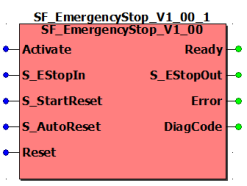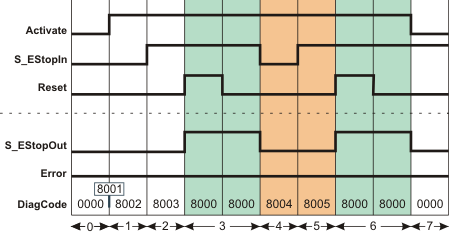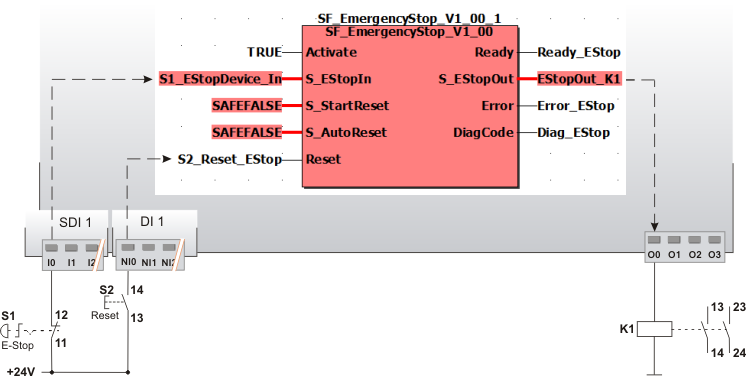The following description is valid for the function block SF_EmergencyStop_V1_0z, Version 1.0z (where z = 0 to 9).
Short description
|
The safety-related SF_EmergencyStop function block monitors the switching states of an emergency-stop control device. When the connected emergency-stop device is activated, the enable signal at output S_EStopOut becomes SAFEFALSE. S_StartReset can be used to specify a start-up inhibit and S_AutoReset can be used to specify a restart inhibit. |

|
Function block inputs
Click the corresponding hyperlinks to obtain detailed information on the items below.
|
Name |
Short description |
Value |
|
State-controlled input for activating the function block. Data type: BOOL Initial value: FALSE |
|
|
|
State-controlled input for the status of the emergency-stop control device. Data type: SAFEBOOL Initial value: SAFEFALSE |
|
|
|
State-controlled input for specifying the start-up inhibit after the Safety Logic Controller has been started up or the function block has been activated. An active start-up inhibit must be removed manually by means of a positive signal edge at the Reset input. A deactivated start-up inhibit causes the S_EStopOut output to switch to SAFETRUE automatically when the function block is activated and the safety-related function is not requested. Data type: SAFEBOOL Initial value: SAFEFALSE Refer to the first hazard message below this table. |
|
|
|
State-controlled input for specifying the restart inhibit after the SAFETRUE signal has returned at the S_EStopIn input, i.e., after the previously activated emergency-stop control device has been deactivated again. An active restart inhibit must be removed manually by means of a positive signal edge at the Reset input. A deactivated restart inhibit causes the S_EStopOut output to switch to SAFETRUE automatically when the function block is activated and the safety-related function is no longer requested. Data type: SAFEBOOL Initial value: SAFEFALSE Refer to the first hazard message below this table. |
|
|
|
Edge-triggered input for the reset signal:
Refer to the second hazard message below this table. Data type: BOOL Initial value: FALSE NOTE: Resetting does not occur with a negative (falling) edge, as specified by standard EN ISO 13849-1, but with a positive (rising) edge. |
|
WARNING
NON-CONFORMANCE TO SAFETY FUNCTION REQUIREMENTS
Verify the impact of a deactivated start-up inhibit (S_StartReset = SAFETRUE) and/or restart inhibit (S_AutoReset = SAFETRUE) on your machine or process prior to implementation.
Observe the regulations given by relevant sector standards regarding the start-up/restart inhibit.
Verify that a suitable start-up inhibit is in place at another location or using other means.
Failure to follow these instructions can result in death, serious injury, or equipment damage.
Resetting the function block by means of a positive signal edge at the Reset input can cause the S_EStopOut output to switch to SAFETRUE immediately (depending on the status of the other inputs).
WARNING
UNINTENDED START-UP
Include in your risk analysis the impact of the reset by means of a positive signal edge at the Reset input.
Make certain that appropriate procedures and measures (according to applicable sector standards) have been established to help avoid hazardous situations when resetting.
Do not enter the zone of operation when resetting.
Ensure that no other persons can access the zone of operation when resetting.
Use appropriate safety interlocks where personnel and/or equipment hazards exist.
Failure to follow these instructions can result in death, serious injury, or equipment damage.
Function block outputs
Click the corresponding hyperlinks to obtain detailed information on the items below.
|
Name |
Short description |
Value |
|
Output for signaling "Function block activated/not activated". Data type: BOOL |
|
|
|
Output for enable signal of the function block. Data type: SAFEBOOL |
|
|
|
Output for error message. Data type: BOOL |
|
|
|
Output for diagnostic message. Data type: WORD |
Diagnostic message of the function block. The possible values are listed and described in the topic "Diagnostic codes". |
Signal sequence diagram
This diagram relates to a typical emergency-stop function with an active start-up inhibit and an active restart inhibit:
S_StartReset = SAFEFALSE: Start-up inhibit after the function block has been activated and the Safety Logic Controller has started up
S_AutoReset = SAFEFALSE: Restart inhibit after the connected emergency-stop control device has been deactivated (SAFETRUE signal returns at the S_EStopIn input)
NOTE:
The other signal sequence diagram can be taken into account.
NOTE:
The signal sequence diagrams in this documentation possibly omit particular diagnostic codes. For example, a diagnostic code is possibly not shown if the related function block state is a temporary transition state and only active for one cycle of the Safety Logic Controller.
Only typical input signal combinations are illustrated. Other signal combinations are possible.

|
0 |
The function block is not yet activated (Activate = FALSE). As a result, all outputs are FALSE or SAFEFALSE. |
|
1 |
After the function block has been activated by Activate = TRUE, the start-up inhibit is active at first. |
|
2 |
The previously activated emergency-stop control device is deactivated (N/C contacts closed). The S_EStopOut output remains SAFEFALSE at first, as S_StartReset = SAFEFALSE prevents automatic start-up. |
|
3 |
Positive signal edge at the Reset input removes the start-up inhibit, followed by normal operation. The S_EStopOut output becomes SAFETRUE. |
|
4 |
Emergency-stop request. The control device is activated. The S_EStopOut output becomes SAFEFALSE. |
|
5 |
The emergency-stop control device is deactivated again and the S_EStopOut output remains SAFEFALSE at first, as the restart inhibit has been specified by S_AutoReset = SAFEFALSE. |
|
6 |
Positive signal edge at the Reset input removes the start-up inhibit, followed by normal operation. The S_EStopOut output becomes SAFETRUE. |
|
7 |
The function block activation is reset (Activate = FALSE), S_EStopOut output = SAFEFALSE. |
Application example
This example illustrates a single-channel connection of the N/C contact of an emergency-stop control device S1 with the safety-related SF_EmergencyStop function block. The emergency-stop control device is connected to input terminal I0 of the safety-related input device SDI with an ID of 1.
In this example the following applies:
The signal of the input terminal I0 of the safety-related input device SDI 1 is assigned to the global I/O variable S1_EStopDevice_In. This global I/O variable is connected to the S_EStopIn input of the function block for evaluation.
The global I/O variable EStopOut_K1 is connected to output S_EStopOut of the function block. This global I/O variable has the O0 output terminal of the Safety Logic Controller as address.
The function block is perpetually activated by the TRUE constant at the Activate input.
S_StartReset = SAFEFALSE specifies a start-up inhibit after the Safety Logic Controller has been started up or the function block has been activated. Furthermore, S_AutoReset = SAFEFALSE specifies a restart inhibit of the function block after the emergency-stop control device has been deactivated, i.e., once the SAFETRUE signal has returned at the S_EStopIn input. Both inhibits are only removed when there is a positive signal edge at the Reset input.
To this end, the S2 reset button is connected to input NI0 of the standard input device DI 1.

|
S1 |
Emergency-stop |
|
S2 |
Reset |
Further Information
The other application examples and the accompanying notes can be taken into account.
Detailed information
Additional information is available in the following sections: